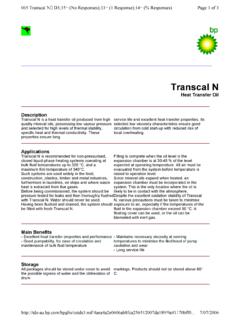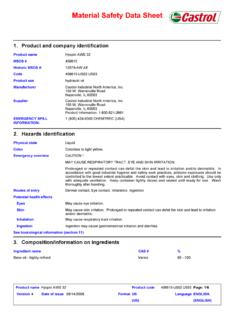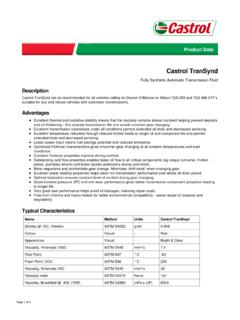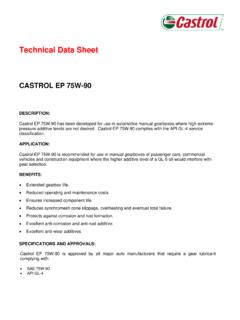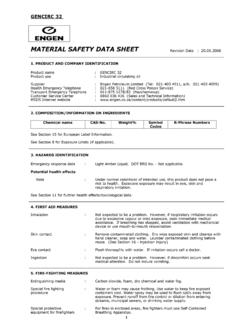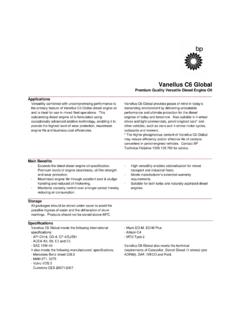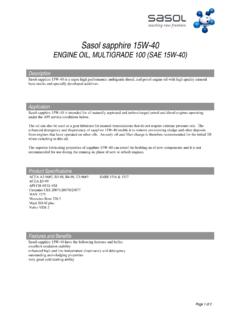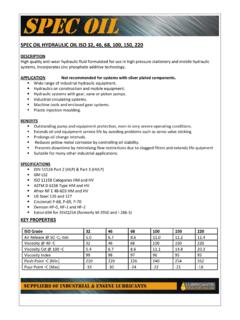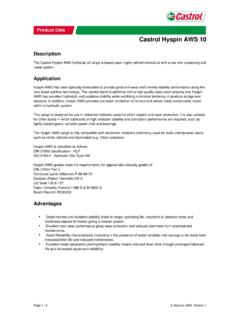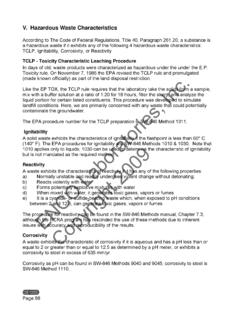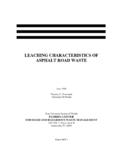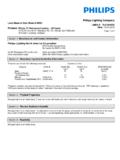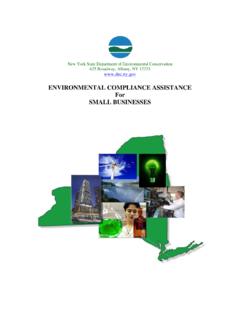Transcription of MATERIAL SAFETY DATA SHEET - Lubricants Online
1 ENGEN TQH 20/68 1 MATERIAL SAFETY data SHEETR evision Date : 1. PRODUCT AND COMPANY IDENTIFICATION Product name : ENGEN TQH 20/68 Product use : Hydraulic oil Supplier : Engen Petroleum Limited (Tel: 021-403 4911, a/h: 021-403 4099) Health Emergency Telephone : 021-658 5111 (Red Cross Poison Service) Transport Emergency Telephone : 011-975 1278/83 (Hazchemwise) Customer Service Center : 0860 036 436 (Sales and Technical Information) MSDS Internet website : 2. COMPOSITION/INFORMATION ON INGREDIENTS Chemical Numbers See Section 15 for European Label Information.
2 See Section 8 for Exposure Limits (if applicable). 3. HAZARDS IDENTIFICATION Emergency response data : Amber Liquid. DOT ERG No. - Not applicable. Potential health effects Note : Under normal conditions of intended use, this product does not pose arisk to health. Excessive exposure may result in eye, skin andrespiratory irritation. See Section 11 for further health effects/toxicological data . 4. FIRST AID MEASURES Inhalation : Not expected to be a problem. However, if respiratory irritation occursdue to excessive vapour or mist exposure, seek immediate medicalassistance.
3 If breathing has stopped, assist ventilation with mechanicaldevice or use mouth-to-mouth resuscitation. Skin contact : Remove contaminated clothing. Dry wipe exposed skin and cleanse withhand cleaner, soap and water. Launder contaminated clothing beforereuse. (See Section 16 - Injection Injury) Eye contact : Flush thoroughly with water. If irritation occurs call a doctor. Ingestion : Not expected to be a problem. However, if discomfort occurs seekmedical attention. Do not induce vomiting.
4 5. FIRE-FIGHTING MEASURES Extinguishing media : Carbon dioxide, foam, dry chemical and water fog. Special fire fightingprocedure : Water or foam may cause frothing. Use water to keep fire exposedcontainers cool. Water spray may be used to flush spills away fromexposure. Prevent runoff from fire control or dilution from enteringstreams, municipal sewers, or drinking water supply. Special protectiveequipment for firefighters : For fires in enclosed areas, fire fighters must use Self-ContainedBreathing Apparatus.
5 ENGEN TQH 20/68 2 Unusual fire and explosivehazards : None. Products of decomposition : Fumes, smoke, carbon monoxide, sulphur oxides, aldehydes and otherdecomposition products, in the case of incomplete combustion. Flash Point : 215 C (ASTM D-92)Upper Explosion Limit : %(V) Lower Eplosion Limit : %(V) NFPA Hazard Id : Health: 0; Flammability: 1; Reactivity: 0 6. ACCIDENTAL RELEASE MEASURES Procedure if MATERIAL isreleased or spilled : Report spills/releases as required to appropriate authorities.
6 Methods for cleaning up : LAND SPILL: Shut off source taking normal SAFETY precautions. Takemeasures to minimize the effects on ground water. Recover by pumpingusing explosion-proof equipment or contain spilled liquid with sand orother suitable absorbent and remove mechanically into containers. Ifnecessary, dispose of absorbed residues as directed in Section 13. WATER SPILL: Notify port and relevant authorities. Confine with boomsif skimming equipment is available to recover the spill for later recyclingor disposal.
7 Warn other ships in the vicinity. If allowed by regulatory authorities theuse of suitable dispersants should be considered where recommended inlocal oil spill procedures. Personal precautions : See Section 8. Environmental precautions : Prevent spill from entering municipal sewers, water sources or low lyingareas. Advise the relevant authorities if contaminations have occurred. 7. HANDLING AND STORAGE Safe handling advice : No special precautions are necessary beyond normal good hygienepractices.
8 Storage information : Keep containers closed when not in use. Do not store in open orunlabelled containers. Do not store near heat sources, sparks, flames,strong oxidizing agents and combustible materials. Storage and handlingprocedures : Prevent small spills and leakages to avoid slip hazard. 8. EXPOSURE CONTROLS / PERSONAL PROTECTION Occupational Exposure Limits (OELs) LTEL: Long Term Exposure Limits - Time Weight Average (TWA) over 8 hours. STEL: Short Term Exposure Limits - Time Weight Average (TWA) over 15 Minutes Note: Limits Shown for guidance only.
9 Follow applicable regulations. Personal Protection Equipment (PPE) Engineering controls : If mists are generated, use ventilation, local exhaust or enclosures tocontrol below exposure limits. Respiratory protection : Approved respiratory equipment must be used when mist concentrationsexceed the recommended exposure limits. Eye protection : If splash with liquid is possible, chemical type goggles should be worn. Skin and body protection : No special equipment required. However, if frequent splashing or liquidENGEN TQH 20/68 3 contact is likely to occur, wear oil impervious gloves and clothing.
10 Goodpersonal hygiene practices should always be followed. 9. PHYSICAL AND CHEMICAL PROPERTIES Appearance : Liquid. Colour : Amber Odour : Mild Solubility : Negligible Boiling point/range : > 316 C Flash Point : 215 C (ASTM D-92) Vapour pressure : < hPa Density : g/cm3 @ 20 C (ASTM D-4052) Pour point : -12 C Viscosity, kinematic : mm2/s @ 40 C (ASTM D-445) mm2/s @ 100 C (ASTM D-445) 10. STABILITY AND REACTIVITY Stability : Stable.
